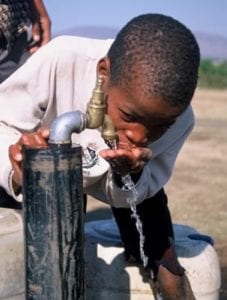Sub-Saharan Africa still has a long way to go to meet the 2015 Millennium Development Goal (MDG) targets. Close to half of the global population without water resides in sub-Saharan Africa. The region has also made little progress on improving sanitation, the latest update by Unicef reveals.
Water Between 1990 and 2012, 2.3 billion people gained access to an improved drinking water source, raising global coverage to 89% in 2012. Despite strong overall progress, 748 million people still did not have access to improved drinking water in 2012, of which 325 million (43%) live in sub-Saharan Africa. The world met the MDG target for drinking water in 2010, but 45 countries are still not on track to meet the target by 2015. Most of these are in sub-Saharan Africa. According to the report, the combination of a low 1990 baseline with high population growth exacerbates the challenges of meeting the MDG target in this region. On average, these countries had to increase drinking water coverage by 26 percentage points – which for some meant a doubling of their 1990 coverage levels. Despite the fact sub-Saharan Africa is not on track to meet the MDG drinking water target, progress has been impressive. Since 2000 almost a quarter of the current population (24%) gained access to an improved drinking water source – that is, on average, over 50 000 people per day, every day, for 12 consecutive years. Sanitation Despite increases in sanitation coverage, progress has been slow and the world is not on track to meet the MDG sanitation target. 69 countries were not on track in 2012, 36 of them in sub-Saharan Africa. Although accelerated efforts in sub-Saharan Africa have delivered results in some countries, such as Ethiopia and Angola, progress is the second lowest of any region after Oceania.Sub-Saharan Africa has made slow progress. Its coverage of 30% reflects only a 5 percentage point increase since 1990. In fact, Nigeria has seen a decline in coverage of improved sanitation, from 37% in 1990 to 28% in 2012.
Open defecation 82% of the one billion people practising open defecation in the world live in just 10 countries. In sub-Saharan Africa open defecation has increased in 26 of 44 countries. Nigeria has seen the largest increase in numbers of open defecators since 1990, with 39 million people defecating in the open in 2012, compared with 23 million in 1990. A closer look Despite the poor overall picture, according to data released by Unicef earlier this year, some African countries are on track to meet their targets.| Country | MDG water target | MDG sanitation target |
| Angola | Off-track | On-track |
| Botswana | Near universal | On-track |
| DR Congo | Off-track | Off-track |
| Lesotho | Off-track | Off-track |
| Madagascar | Off-track | Off-track |
| Malawi | On-track | Off-track |
| Mauritius | Near universal | Off-track |
| Mozambique | Off-track | Off-track |
| Namibia | On-track | Off-track |
| Seychelles | Near universal | Near universal |
| South Africa | On-track | Off-track |
| Swaziland | On-track | Off-track |
| Tanzania | Off-track | Off-track |
| Zambia | Off-track | Off-track |
| Zimbabwe | Off-track | Off-track |








